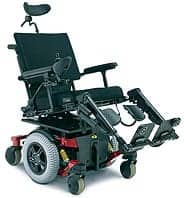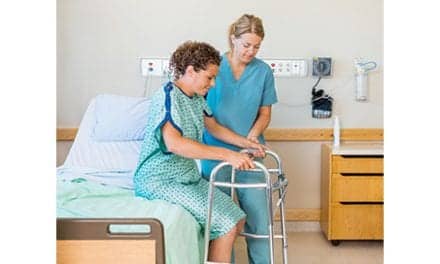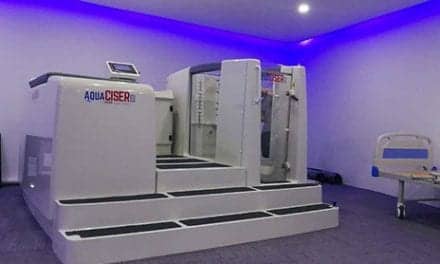 |
Urban myth insists that the head of the US Patent Office in 1899 pridefully proclaimed there were no more inventions to be invented because everything that could be invented already had been invented. Unquestionably, it takes hubris—coupled with a serious lack of vision and a failure of imagination—to articulate such an absurdity, which is probably why no one actually ever said it. And yet, today, there are some in the rehab profession who can’t help but wonder if the era of innovation in power mobility is now past.
Hard to blame them for thinking that way. There have not been any blockbuster technologic advances in power wheelchair and scooter technology for a while now. But that does not mean the wheels of invention have ground to a halt. Far from it.
“Every vendor I’ve talked to lately is busy with research and development efforts,” says Jerry Keiderling, vice president of US Rehab, a buying group based in Waterloo, Iowa.
Quantum Rehab, Exeter, Pa, is one of those R&D-immersed manufacturers, and Cody Verrett, ATS, director of clinical education, expresses confidence that big things are in store for the industry. “I think we’re on the cusp of revolutionary improvements in both motor technology and materials,” he says. “We’re going to see—very soon, possibly—power wheelchairs and scooters offering significantly more range without sacrificing torque to achieve it. It’s technologically feasible.”
Although the market has of late been deprived of big innovation, power mobility devices (PMDs) have gotten incrementally better and better in the last 2 or 3 years. Mark Grillo, CRTS, of ATG-Wheelchair Center, says the PMDs he supplies out of his Sacramento, Calif, shop are much lighter in weight than they were just 2 years ago. They are also more durable and deliver greater performance. “Mid-wheel drive design—with its significantly smaller turning radius—has really taken over the power wheelchair market,” he says. “These chairs are a lot more outdoor-friendly. They’re also being equipped with tilt-and-recline seating systems.”
During his visit to the most recent Medtrade convention, Larry Rice found his attention captured by a number of new electronics packages for PMDs. “The electronics being demonstrated at the show offered an amazing degree of programmability,” says Rice, president of In Home Products Inc, a Dallas supplier of power mobility products.
WRINGING OUT COSTS
All of this bodes well for rehab professionals and their clients and patients. However, the currently roiled reimbursement situation raises the possibility that product innovation may be forced to take some unexpected turns between here and the future.
New CMS Coding for PMDs |
|
It appears the suppliers of power mobility devices have dodged a bullet aimed at them in the form of Medicare downcoding. Local coverage determination rules originally adopted by the Centers for Medicare and Medicaid Services (CMS) in conjunction with the 60 new codes for PMDs would have allowed Medicare contractors to virtually rewrite physician prescriptions. “The rules permitted downcoding of the mobility prescription to what the DMERCs were calling ‘the least costly alternative,'” says Cara Bachenheimer, Alexandria, Va-based vice president of government relations for Invacare, Elyria, Ohio. “The result would have been Medicare paying for a device that was probably not the most medically appropriate for the patient, perhaps detrimentally so.” Political pressure brought to bear on CMS from beneficiaries, interest groups, and Congress resulted in a revised set of rules, issued September 20. “The language is greatly improved,” says Bachenheimer. “The primary improvement is the essential elimination of downcoding.” However, rehab suppliers are not yet out of the woods, she warns. “There are still some significant issues that need to be addressed and resolved,” says Bachenheimer. “The issues still on the table are those that mainly affect PMDs at the higher end, the Group 3s. The basic coverage criteria state that an individual who qualifies for a Group 3 chair is one who is unable to independently stand and pivot transfer. The term ‘independently’ is newly added, but, still, this language is inappropriate and should be eliminated” because the way CMS means it and the way clinicians are trained to understand it are miles apart. Another issue centers around patients with long-term disabilities, particularly those with progressive disease. Says Bachenheimer, “The policy at present does not allow the prescriber or therapist to take into account the future medical needs of the patient. For example, someone with MS could, 6 months after qualifying for a specific chair, be in a significantly worse condition. So, the product prescribed and provided today may not be at all medically appropriate half a year later—and Medicare will not pay again for that patient to receive another chair until they have gotten 5 years of use out of the originally prescribed product.” At least in theory, it now will not be possible for a Medicare contractor to compel a patient who needs a Category 2 PMD to instead accept a Category 1. “That kind of thing is not supposed to happen,” says Bachenheimer. “We’ve received verbal assurance that it won’t. But it’s not crystal clear in the policy. And because it’s not, we’re still seeking further clarification.” Meanwhile, documentation in support of PMD prescriptions looms large as an issue also needing attention. Bachenheimer thinks therapists and suppliers would do well to help physicians be able to fully satisfy CMS’s new rules for detailing patient health status. “The requirements are fairly amorphous,” she says. “The DMERCs in mid-July issued some guidance, but we see from it that CMS is expecting far more extensive documentation involving far more detail in the medical records than physicians typically provide.” Education of physicians is therefore essential, says Eric Sokol, director of the Power Mobility Coalition in Washington, DC. “I would recommend that, for starters, rehab professionals visit the CMS Web site,” he says. There they will find a number of code-related educational articles, which can be sent to physician offices as a link to those articles or as a hard-copy printout in their entirety. Rehab professionals also could offer to conduct in-services or seminars for those offices.” —R.S. |
The biggest reimbursement-related challenge confronting manufacturers (and everyone else in the supply chain) is the twice-delayed arrival of the 60 new Medicare billing codes specifically for PMDs (the codes are scheduled to at last take effect this November).
Ross Charest of PMD maker Sunrise Medical told Rehab Management earlier this year that the changes embodied by the new codes and their accompanying implementation policies mean manufacturers who will succeed in going forward will have to develop new efficiencies in all aspects of their processes—from R&D through delivery to the user.
Calvin Cole, vice president of Hoveround in Sarasota, Fla, holds a similar view. “Most manufacturers are trying to wring costs out any way they can; that’s how they’re going to keep their margins and still be able to deliver product to the beneficiaries,” he says. That’s essential because, as Grillo points out, “If you’re getting only a limited amount of revenues from your existing products because of the way reimbursements are, you just have that much less money to devote to R&D.”
Keiderling thinks this state of affairs may spur manufacturers to form collaborative partnerships with one another so they can share R&D costs. “I don’t see them pooling ideas for products, but I do see them pooling their resources so they can cooperatively buy raw materials and components in greater volume than would be possible buying separately,” he says. “It would be another way for them to drive costs out of R&D.”
In the short term, the overarching goal of PMD makers is simply to roll out products that can qualify for reimbursement under the new Medicare codes, Grillo reports. “They’re doing a fine job with that, but they’ve had to make a few trade-offs,” he says. “The newest offerings from manufacturers are definitely code-friendly, except that they now have fewer options. The fewer options are part of what makes them code-friendly.”
Paul Komishock, manager of reimbursement services at Pride Mobility Corp, explains that the intention of the new Medicare codes is not to force manufacturers to fit square pegs in round holes, but, rather, to accurately reflect and be descriptive of what is available for patients today. Whether that is how manufacturers see it is a matter open to debate.
According to Komishock, the rules surrounding the new codes focus on several basic issues. “First, power wheelchairs are now going to be characterized by weight capacity,” he says. “Medicare divides them into four ranges: less than 300 pounds; 301 to 450 pounds; 451 to 600 pounds; and 601 pounds and higher. In other words, the patient’s weight now automatically narrows the number of chairs he is potentially going to qualify for.
“As to the patient’s seating needs, Medicare will now pay for the chair only if the patient needs power-positioning and specialty cushions at the time they get the chair—future need will not be taken into account. Also, the new rules say the patient qualifies for a high-end Category 3 chair if he has a neurologic condition or a myopathy that prevents him from independently standing and performing a pivot transfer.”
GROUNDS FOR CONCERN
While manufacturers are trying hard to live up to the letter and spirit of the new rules, not everyone in the rehab world is comfortable with what the Centers for Medicare and Medicaid Services have wrought. Among those voicing reservations is the Power Mobility Coalition, the Washington, DC-based nationwide association of manufacturers and suppliers of power mobility devices. “We’re concerned about the way the codes and one of their key elements—the policy of local coverage determination of patient eligibility—will interact, especially when yet-to-be-announced pricing is added to the mix,” says attorney Stephen Azia, counsel to Power Mobility. “We’re concerned that they will interfere with the ability of patients to receive the equipment they need in order to conduct activities of daily living.”
The local coverage determination rule to which Azia refers allows Medicare’s contractors to engage in downcoding. Says Power Mobility Coalition Director Eric Sokol, “Assume a physician writes a prescription for a Category 2 power wheelchair. The Medicare contractor can override that prescription and downgrade it to a lightweight, low-performance Category 1 chair, something cheaply manufactured offshore. Our position is that the ability to downcode—in effect, to second-guess the doctor—will result in safety issues for patients and health issues as well. The chairs they’re going to end up in will not be designed for outdoor use, but many will attempt to use them in that environment. Also, the low-performance chairs will not allow for proper seating and positioning in many instances, so users can expect skin breakdowns and other physiological problems.
“Ultimately, the ability to downcode could undermine the manufacturing of chairs in the United States and cause suppliers to increase purchases from overseas in order to deal with the problem,” he says, leading to an eventual flooding of the domestic market with product that hurts patients more than it helps.
So, where does all this leave PMD innovation? Surprisingly, in a position that is not quite as jeopardized as it appears.
History certainly is on the side of Rice’s reasoning. Says Cole, “Between 1995 and 2003, Medicare expenditures for mobility products increased 2,000%.” That, of course, is because more and more people over the years have needed power mobility devices.
Cy Corgan, national sales director for retail mobility at Pride, perhaps says it best. “Consumers want to stay mobile. They want products that are portable, maneuverable, and stylish. They’re also looking for products that blend quality and low cost. That’s why we’re not about to let up on our R&D. We’re looking to be innovative at every level possible to deliver the best possible product.”
(Editor’s Note: For more information on power mobility, please read “New CMS Codings for PMDs” (above) and “The Technology of Mobilty” (below). Also, to access the PMD fee schedule amounts for all states, go to www.cms.hhs.gov/DMEPOSFeeSched/LSDMEPOSFEE/list.asp)
Rich Smith is a contributing writer for Rehab Management. For more information, contact
The Technology of Mobility |
|
In the world of power mobility devices, much innovation at present centers around electronics. Quantum Rehab, for example, unveiled in September its Q-Logic advanced electronics system that incorporates a full-color display. “It includes consumer features such as a photo album and a real-time clock, but also helpful info about the chair itself, such as a speedometer and a readout showing percentage of battery power remaining before the charge is exhausted,” says Cody Verrett, ATS, director of clinical education for Quantum Rehab. “It also offers clinician-friendly features—a tilt sensor, along with an odometer to track utilization.” That is not to say makers haven’t paid attention to the other elements that go into a PMD. Recently introduced by Permobile is a power wheelchair that offers a remarkable degree of seating-and-positioning modularity along with flexibility to accommodate the changing needs of users. Hoveround, meanwhile, is out with its new MPV5 wheelchair. This workhorse power ride offers a flip-up footplate, different seating options, better motor efficiency, and longer range. Pride Mobility sees a gathering of speed in the travel mobility segment of the scooter market, which it is seeking to dominate with its Go Go Ultra X and Go Go Elite Traveller (the former being a noncoded scooter, while the latter comes under the new Medicare codes). Sunrise Medical moved fast with the rollout of its new Quickie Rhythm and Groove rehab power chairs. Featuring an advanced 6-wheel, independent suspension system, the Rhythm is designed to take on rough terrain and climb 3-inch curbs without sacrificing user comfort. It also marked the introduction of state-of-the-art Quickie Electronics, which were developed in partnership with Delphi™. Recently added to the Invacare lineup is the mid-wheel-drive Pronto R2, employing HexaFlex technology to keep the chair’s six wheels on the ground at all times. Highly maneuverable, the 300-pound version of the R2 can make a top speed of 5.5 mph. —R.S. |





